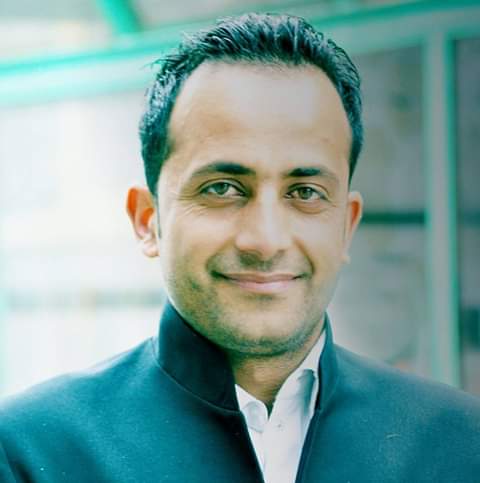Scientific Program
Keynote Session:
A PHP Error was encountered
Severity: 8192
Message: trim(): Passing null to parameter #1 ($string) of type string is deprecated
Filename: pastconference/past-program-schedule.php
Line Number: 239
Backtrace:
File: /efsdata/meetingsint-com/application/views/pastconference/past-program-schedule.php
Line: 239
Function: trim
File: /efsdata/meetingsint-com/application/controllers/Pastconference.php
Line: 128
Function: view
File: /efsdata/meetingsint-com/index.php
Line: 317
Function: require_once
Title: Color doppler in Fetal Hypoxia : An aid in diagnosis, management and timely termination
Biography:
Dr. Kuldeep Singh has been practicing ultrasound for over 18 years in South Delhi, INDIA. He is known for his ultrasound skills in Anomaly Scanning Color Doppler Scanning and High risk pregnancy evaluation. He has more than 150 lectures in various national and international conferences. He has more than 100 articles and chapters to his credit and has authored 16 books on Ultrasound in Obstetrics, Gynecology and Infertility. His books have been translated into Spanish, Chinese and Portugese. The IMAGING SCIENCE AWARD was honored to him at the AICOG 2008. He has been appointed as associate director of Ian-Donald Inter University School of Medical ultrasound.
Abstract:
The uteroplacental and fetoplacental circulations can be assessed by color Doppler a non-invasive method for understanding and studying fetal circulations. The uterine artery flow tells us the status of the uteroplacental circuit. The umbilical artery, middle cerebral artery, descending aorta, ductus venosus and umbilical vein study tells us the fetal adaptation to any hypoxic insult. With impaired placentation causing changes in the uterine artery one needs to be carefully surveying the fetal circulation for any adaptive changes. With hypoxic insult the blood flows preferentially to vital organs like the brain, heart and adrenals with compensatory shunting from the non-vital organs the abdominal viscera and lower limbs. The three ratio Systolic/Diastolic ratio, Pulsatility Index and Resistive Index are markers of resistance and thus are reflecting impedance values which are inversely proportional to the amount of blood flow in the respective vessel or organ. So brain sparing causes a high PI and brain edema would finally cause a rise in the Middle cerebral artery PI.
This tool finally helps us to fine tune the administration of steroids in a premature fetus and timely termination of pregnancy to reduce the stay of the neonate in the ICU and reduce neonatal morbidity and mortality.
A PHP Error was encountered
Severity: 8192
Message: trim(): Passing null to parameter #1 ($string) of type string is deprecated
Filename: pastconference/past-program-schedule.php
Line Number: 239
Backtrace:
File: /efsdata/meetingsint-com/application/views/pastconference/past-program-schedule.php
Line: 239
Function: trim
File: /efsdata/meetingsint-com/application/controllers/Pastconference.php
Line: 128
Function: view
File: /efsdata/meetingsint-com/index.php
Line: 317
Function: require_once
Title: Effects of a mobile supportive care program on depression in oral cancer patients underwent surgery
Biography:
Yu-Hua Lin has completed her PhD degree from the school of nursing, Kaohsiung Medical University, Taiwan. She had 35 years working experience in the field of nursing. Now, she is a professor in the school of nursing, I-Shou University in Taiwan R.O.C. She has published more than 50 papers in reputed journals and has been serving as an editorial board member of the Journal of Nursing in Taiwan Nurses Association.
Abstract:
The purpose of this study was to examine the effects of a mobile supportive care program (MSCP) on depressive symptoms in patient with oral cancer underwent oral surgery. A quasi-experimental design with simple randomize sampling, and the Center for Epidemiologic Studies Depression Scale (CES-D) was used to collect participants’ data. Participants were distributed into with a MSCP before discharge (experimental group, n=55) or without used MSCP (control group, n=55). The MSCP was loading in a Line app in experimental group mobile after education. The outcome was followed at the 7 days (first time clinic visited, T1), one month (T2), and three month (T3) after discharge. The CESD scores showed that all the two groups’ participants experienced depressive symptoms decreased at the one and three months after received MSCP (all p<.001). The generalized estimating equation analysis showed that after controlled age, both group and time were significantly different, indicated both group patients experienced depressive symptoms improvement, however, the MSCP group depressive symptoms was improved better than non-MSCP group. An interaction existed between the groups and test times in CESD from Time 1 to Time 3. These results indicate that the MSCP effects were influenced by time. These results showed that the CESD score of the experimental group was significantly lower than that of the control group by 6.51 points at one-month, and 5.60 points at three-month. This results recommend for the healthcare staff embed this MSCP into discharge plan in care of oral cancer patient underwent oral surgery.
Title: Effects of meconium aspiration in new born in developing countries in sub saharan African perspective - How much HIV/AIDs contributes
Biography:
Dr Mir Anwar graduated Medicine from Bangladesh in 1975. He did his post-graduation in Pediatrics from Ireland in 1982. Further he did his Public Health Post graduation- MPH (concentration Maternity and Child Health) from University of Massachusetts, USA in 2003. Then he joins in UN/ WHO and worked as a Pediatric Consultant & Public Health Specialist, around the world including Asia, Middle East, Africa, Pacific Island, Ireland and USA. Since 2007 he has been working in South Africa in different provinces of South Africa with the Department of Health. Presently he is working as a Clinical Medical Manager in Richmond Chest Hospital, KZN. South Africa. His main research interest presently is, Childhood TB with HIV in Sub-Saharan Africa. In his long carrier in Pediatric and Public Health he had attended several International Congress, Conferences, and Seminars and presented his original work. Some of them were published in International Journal Including American Child Neurology Journal, Japan Pediatric Neurology Journal, Pakistan Pediatric Journal, Bangladesh Child Medical Journal, Nigerian Journal of Obstratics and Gynecology Etc.
For his work he is honored by American Academy of Pediatrics, Royal College of Health, UK, and International College of Pediatrics. Etc. His Biography was published in Who’s Who in Medicine Cambridge, UK in 1985. He is an active member of different International and National Pediatric Organization, Association etc. Presently is one of the honorary Member of Editorial Board- Journal of Pediatrics & Neonatal Biology, Published from Texas, USA.
Abstract:
Background- Sub-Saharan Africa still has the highest child Mortality rates in the world. Global child mortality has dropped by 53% - from 12.7 million in 1990 to 5.9 million in 2015. South Africa has reduced its child mortality rate from 60 deaths per every 1000 live births in 1990 to 41 in 2015. Though the MDG target is 20.
Objective- To find out the Infant Mortality due to Meconium Aspiration Syndrome how much it contribute in Child Mortality where Home delivery & HIV/AIDS are predominated.
Methods- Our study were overserved & put on consideration of the following criteria –
Detection of Prematurity and Fetal gasping secondary to hypoxia, inadequate removal of meconium from the airway prior to the first breath, Use of positive pressure ventilation (PPV) prior to clearing the airway of meconium etc.
The inhaled meconium can cause a partial or complete blockage of the airways, causing difficulty breathing and poor gas exchange in the lungs. In addition, the substance is irritating and causes inflammation in the airways and potentially, causes chemical pneumonia. Factors that promote the passage of meconium in utero include the following: Placental insufficiency, maternal hypertension .Preeclampsia, Oligohydramnios, maternal drug abuse, especially of tobacco and cocaine, maternal infection-corioaminitis, etc.
Results- The possibility of inhaling meconium occurs in and around 10% of all births. Out of this 1-3% causes MAS. Its generally happens after 34 to 42weeks of gestation.30% of them needs ventilation. In the industrialized world, meconium in the amniotic fluid can be detected in 8-25% of all births after 34 weeks' gestation. Of those newborns with meconium-stained amniotic fluid, approximately 10-15% develop meconium aspiration syndrome.
Conclusion- Our study concludes in HIV/AIDS and TB predominated developing countries with less availability of prenatal care and where home births are common, incidence of meconium aspiration syndrome is thought to be higher than, and is associated with a greater infant mortality rate.
Title: Educational needs for strengthening the quality of Japanese nurse educators
Biography:
Atsuko Watanabe has completed a Master degree from Kyoto University School of Public Health. She is a Ph.D. student at Division of Health Sciences, Osaka University Graduate School of Medicine, specializing in Nursing Education and Nursing Management. She is a lecturer at Faculty of Nursing and Health Care, Baika Women's University, Osaka, Japan.
Abstract:
Background: Career development and continuing education are essential for nurses to develop their professional competencies. Nurse educators are expected to provide those programs catered to the needs of nurses with validated effectiveness. However, there are few opportunities for Japanese nurse educators to receive educational training for improving their quality and skills. This study aimed to identify the educational needs for nurse educators, as perceived by certified nurse administrators.
Methods: A cross-sectional survey was conducted among 228 Japanese certified nurse administrators who were randomly selected. A questionnaire was developed based on the standards of continuing education and group interviews. Simple tabulation was performed, and free descriptions were coded and categorized according to meaning in order to identify the educational needs for nurse educators.
Results: A total of 101 certified nurses responded to the questionnaire. Nine categories were identified for nurse educators to be strengthened; communication, self-development, building personal relationships, management, human resource development and career development, planning and practical skills, analysis and evaluation, education (general and nursing), and nurse educator development seminars.
Conclusion: Building a support system and providing educational programs are needed for Japanese nurse educators to develop their professional competencies and skills.
Title: Best International Medical Oncology Researcher Award 2020 at Public Health Webinar on 9th July in London, United Kingdom (GMT+1)
Biography:
Dr. Qudratullah Muslim, Medical Doctor and Lecturer.
Dr. Qudratullah Muslim Had studied primary education in Helmand -Afghanistan And had studied higher Education In Delhi-india And Kabul -Afghanistan.
Abstract:
Gastric cancer
Gastric cancer (GC) is the fourth most common cancer in the world. When cancer cells form in the inner lining of stomach these cells can grow into a tumor. Which called gastric cancer, the disease usually grows slowly over many years.GC is a multifactorial disease comprehending lifestyle, aging, genetic, socioeconomic factors, and also infection by Helicobacter pylori, which has been attributed in 80% of the cases and Epstein-Barr virus (present in 6-10% of cases). One of the great problems of gastric cancer is the late disease detection caused by the nonspecific symptomatology in early stages which is associated with poor prognosis. According to Lauren classification the adenocarcinoma presents in two types: type one intestinal well differentiated with cohesive neoplastic cells, forming gland-like tubular strictures: type two diffuse poorly differentiated with infiltration and thickening of the stomach wall without the formation of a discrete mass Early Symptoms on, stomach cancer may cause indigestion ,Feeling bloated after you eat a meal ,heartburn,nausea,Loss of appetite As stomach tumors grow, you may have more serious symptoms, such as stomach pain ,blood in your stool, omitting weight loss Trouble swallowing Yellowish eye ,or skin ,Swelling in your stomach constipation or diarrhea ,or feeling tired ,Innovative technologies have been used to identify alterations in gastric cancer cell biology, e.g., several genetic abnormalities such as aberrant genes, copy number variation, micro RNAs, and long noncoding RNAs were identified as possible biomarkers in these studies.so prevention of stomach cancer. Though stomach cancer is the fourth most common cancer in the world, the number of cases has dropped over the past. Several decades there’s no guarantee you can prevent it, but there's plenty you can do to lower your chances of having it. Here's how to give you every possible advantage check on ulcer helicobacter pylori is common bacteria it doesn’t make always sick but it can infect on stomach lining and cause ulcer and it is also a carcinogen which means it can cause cancer so to treat early ulcer, pile on the produce make sure each meal includes fruits vegetables can lower chance of GC...
Title: Best International Medical Oncology Researcher Award 2020 at Public Health Webinar on 9th July in London, United Kingdom (GMT+1)
Biography:
Dr. Qudratullah Muslim, Medical Doctor and Lecturer.
Dr. Qudratullah Muslim Had studied primary education in Helmand -Afghanistan And had studied higher Education In Delhi-india And Kabul -Afghanistan.
Abstract:
Gastric cancer
Gastric cancer (GC) is the fourth most common cancer in the world. When cancer cells form in the inner lining of stomach these cells can grow into a tumor. Which called gastric cancer, the disease usually grows slowly over many years.GC is a multifactorial disease comprehending lifestyle, aging, genetic, socioeconomic factors, and also infection by Helicobacter pylori, which has been attributed in 80% of the cases and Epstein-Barr virus (present in 6-10% of cases). One of the great problems of gastric cancer is the late disease detection caused by the nonspecific symptomatology in early stages which is associated with poor prognosis. According to Lauren classification the adenocarcinoma presents in two types: type one intestinal well differentiated with cohesive neoplastic cells, forming gland-like tubular strictures: type two diffuse poorly differentiated with infiltration and thickening of the stomach wall without the formation of a discrete mass Early Symptoms on, stomach cancer may cause indigestion ,Feeling bloated after you eat a meal ,heartburn,nausea,Loss of appetite As stomach tumors grow, you may have more serious symptoms, such as stomach pain ,blood in your stool, omitting weight loss Trouble swallowing Yellowish eye ,or skin ,Swelling in your stomach constipation or diarrhea ,or feeling tired ,Innovative technologies have been used to identify alterations in gastric cancer cell biology, e.g., several genetic abnormalities such as aberrant genes, copy number variation, micro RNAs, and long noncoding RNAs were identified as possible biomarkers in these studies.so prevention of stomach cancer. Though stomach cancer is the fourth most common cancer in the world, the number of cases has dropped over the past. Several decades there’s no guarantee you can prevent it, but there's plenty you can do to lower your chances of having it. Here's how to give you every possible advantage check on ulcer helicobacter pylori is common bacteria it doesn’t make always sick but it can infect on stomach lining and cause ulcer and it is also a carcinogen which means it can cause cancer so to treat early ulcer, pile on the produce make sure each meal includes fruits vegetables can lower chance of GC...
Oral Session 1:
- Evidence Based Practice - Public Health Nursing
Title: A correlational study on visual health related knowledge and health beliefs and uptake of visual health behavior among secondary school students in Hong Kong
Biography:
Dr. Choi is an Associate Professor of the School of Nursing & Health Studies of The Open University of Hong Kong. Her areas of expertise are on nursing education, management and research. She has experiences in conducting both quantitative and qualitative research, and mixed methods research, and has published a no. of papers related to nursing work environment, nursing shortage and student learning.
Abstract:
Background: Secondary school students often spend most time of the day on near-work activities, such as reading, doing homework and using electronic devices. While prolonged near-work activities can lead to visual problems such as eye strain, redness and dryness and blurred vision, there is a need to promote the uptake of visual health behavior among them. This study aimed to examine the factors associated with the uptake of visual health behavior, so as to provide a foundation for promotion of visual health protection among secondary school students in Hong Kong.
Methods: A total of 420 secondary school students were recruited through convenience sampling. Data were collected in early 2018 using a validated 53-item instrument that captured three domains, including visual health related knowledge and health beliefs, as well as uptake of visual health behaviors. Results were analyzed using descriptive statistics and correlational analyses.
Findings: The mean level of knowledge and visual health behavior of respondents was 4.98 out of 9 and 36.26 out of 55 respectively. Significant positive correlations were found between knowledge and perceived susceptibility (r = 0.153), perceived severity (r = 0.375), perceived benefit (r = 0.179), cues to action (r = 0.250) and visual health behavior (r = 0.107). Similarly, significant positive correlations were noted between visual health behavior and perceived susceptibility (r = 0.336), perceived severity (r = 0.325), perceived benefit (r = 0.122) and cues to action (r = 0.211).
Conclusion: Concerted efforts are needed to improve secondary school students’ knowledge and awareness on visual health protection.
A PHP Error was encountered
Severity: 8192
Message: trim(): Passing null to parameter #1 ($string) of type string is deprecated
Filename: pastconference/past-program-schedule.php
Line Number: 354
Backtrace:
File: /efsdata/meetingsint-com/application/views/pastconference/past-program-schedule.php
Line: 354
Function: trim
File: /efsdata/meetingsint-com/application/controllers/Pastconference.php
Line: 128
Function: view
File: /efsdata/meetingsint-com/index.php
Line: 317
Function: require_once
Title: Article on Empathy
Biography:
Prof Karani is a full Professor of Nursing & Nursing Education at University of Nairobi since 2013 and was Associate Professor from 2008. She obtained her doctorate in 2002 from University of Nairobi. She has a wide experience in clinical work in hospital and in community work as well as extensive experience in teaching and research work. She has more than 50 publications in peer reviewed journals and books. Prof. Karani has received several awards for promoting community work and nursing education. These awards include: Queen of England award of Officer (sister) Order of St John of Jerusalem, Daystar & KEMRI (2013); the Head of State Commendation (HSC) which she was awarded during the 40th celebration of Independence on 12th December 2003; the Wharton Fellows Program in Management for Nurse Executives by Johnson & Johnson awarded in 2008;Long service award for IRB KEMRI 2013; Recognition Award for Dedication & Excellence for providing training on HIV/AIDS by Marquette University, School of Nursing in 2003; International Council of Nurses Certificate for Continuing Education in 1999; gold medal for services at the 4th All Africa Games in 2009; and Recognition of Commitment, Diligence and Long Service by National Nurses of Kenya in 2009’ among others. She is currently the Chief Nursing Officer for St. John Ambulance Kenya, the Vice Chair of the Nursing Council of Kenya, Lead Trainer for Leadership For Change for International Council of Nurses (ICN) Kenya. She is a member of both Kenyatta National Hospital/University of Nairobi and the KEMRI, ERC. She also serves as the Chief Editor of the Kenya Nursing Journal. She was the coordinator post-graduate programs and head of Education/ Administration School of Nursing Sciences University of Nairobi. Prof Karani is an external examiner to nursing programs in the region and has initiated some collaboration with local, regional and international nursing programs.
Abstract:
Introduction: Empathy is an affective-cognitive concept that has a rationally mediated set of responses. Family forms the basis of societal identity, kinships and survival. Through families the basis of caring, socialization and identity for individuals is established. Family empathy ensures that family members care for one another as a shared responsibility. This study aimed at describing empathy characteristic values in caring.
Methodology: An explanatory sequential design was used to conduct a qualitative research at Kenyatta National Hospital. A purposive sample of thirty-two nurses were randomly assigned to three focused groups for discussions. Data collection was by verbatim notes and recorded tapes. Data analysis was by correspondence and thematic analysis.
Findings: Empathy involves displaying kindness and concern for others while caring is the state of being aware or informed about needs and intervening to meet that need. The relationship between empathy and caring was significant (p=0.000; p=0.05). Empathy as a value in caring was characterized by kindness, tolerance, listening, understanding and being available to intervene in patient needs. Caring was viewed as ability to achieve patient healthcare satisfaction, boost self-image and esteem for nurses, professional pride, encouraging social cohesion and fosters national unity.
Conclusion: Empathy has its values in family and social structure. A functional family structure prepares individuals to embrace values of empathy and care for others as a personal responsibility. Caring nature of nurses has benefits for both nurses and patients.









